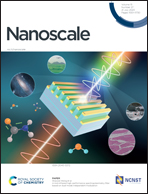Glycofullerene–AuNPs as multivalent ligands of DC-SIGN and bacterial lectin FimH: tuning nanoparticle size and ligand density†
Abstract
Glycoclusters have been extensively investigated for their inhibition of multivalent carbohydrate–protein interactions, which is often the first step for bacterial and viral pathogens to selectively bind their host cells. Glycoclusters may thus prevent infections by blocking the microbe attachment onto the host cell surface. The potency of multivalent carbohydrate–protein interactions is largely derived from the spatial arrangement of the ligand and the nature and flexibility of the linker. The size of the glycocluster may also have a dramatic impact on the multivalent effect. The main objective of this study is to provide a systematic comparison of gold nanoparticles of three representative sizes and ligand densities at their surface. Therefore, AuNPs with diameters of 20, 60, and 100 nm were coupled either to a monomeric D-mannoside or a decameric glycofullerene. Lectin DC-SIGN and lectin FimH were selected as representative models of viral and bacterial infections, respectively. We also report the synthesis of a hetero-cluster built from 20 nm AuNPs and a mannose-derived glycofullerene and monomeric fucosides. All final glycoAuNPs were evaluated as ligands of DC-SIGN- and FimH using the GlycoDiag LectProfile technology. This investigation revealed that the 20 nm AuNPs bearing glycofullerenes with short linker are the most potent binders of both DC-SIGN and FimH. Moreover, the hetero-glycoAuNPs showed an enhanced selectivity and inhibitory ability towards DC-SIGN. Hemagglutination inhibition assays using uropathogenic E. coli corroborated the in vitro assays. Overall, these results showed smaller glycofullerene–AuNPs (20 nm) exhibited the best potential as anti-adhesive materials for a variety of bacterial and viral pathogens.



 Please wait while we load your content...
Please wait while we load your content...